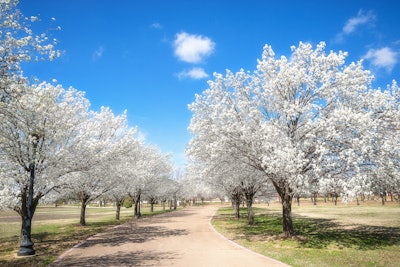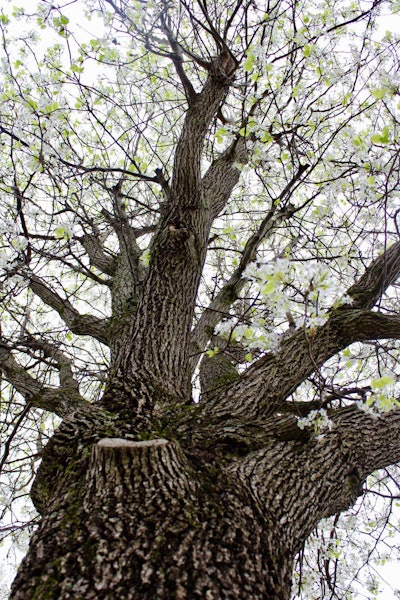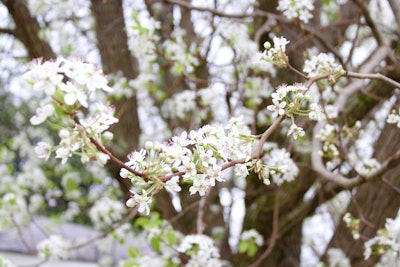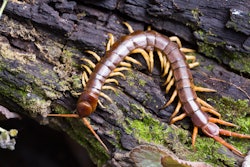
Take a look at a few things you should take into consideration when it comes to Bradford pear trees, as well as some pruning tips associated with this tree.
Safety hazard, offensive odor
The Bradford pear is a nonnative species that was brought over from Asia in the 1960s, according to the Mississippi State University Extension.
These trees can grow to be about 30 to 40 feet tall, and while they are pretty to look at, for many customers, that’s where the appeal ends.
“In certain areas and certain types of landscapes, (Bradford pears have) become a problem and people are starting now to have to deal with the consequences,” Eric Wiseman, an associate professor of urban and community forestry at Virginia Tech, told ABC 13 News.
Bradford pear trees don’t have the same lifespan that most trees do, as this type only lives about 20 to 25 years, and sometimes they don’t even make it to the 20-year mark before falling apart. If a Bradford pear does make it to the age of 25, its branches will be very brittle and prone to breaking.
This tree is notorious for sporting limbs that split away from the main trunk, which creates weak crotches that can allow larger limbs to snap off with little to no warning.
 Photo: Beth Hyatt/Total Landscape Care
Photo: Beth Hyatt/Total Landscape Care“It has a tendency to fork into multiple stems, known as ‘codominant’ stems,” the Mississippi State University Extension says. “These stems have equal diameter, which results in a weak structure. Where such a junction forms in a tree and the bark becomes incorporated into the joint, this is called an ‘included bark junction.’ Branches with included bark are substantially weaker than normal tree forks.”
Customers with these trees in their yard could be looking at safety hazards for parked cars, pets and children that are near the trees if these limbs were to fall.
“The wood is very brittle, so it tends to break up real bad during wind storms,” Stuart Sutphin, an agriculture extension agent with the Virginia Cooperative Extension, told ABC 13 News.“They can grow three, four, five feet a year, so they get up in the power lines very quickly.”
The beautiful white blossoms the Bradford pear tree produces are pleasing to the eye, but the pleasantries end once the odor of said blossoms enters into the equation.
“Although the blossoms are attractive to many, they can have a fairly noxious odor that smells a lot like rotting meat,” the Mississippi State University Extension says. “The smell evolved over thousands of years to attract insects to the blossoms for pollination.”
On a positive note
While the list of negatives far surpasses the good, it’s true that there are, indeed, a few good aspects that accompany the Bradford pear tree.
“While the Bradford pear is often a poor selection for a tree planting, it is not necessarily an environmental catastrophe,” the Mississippi State University Extension says. “Some commentators have claimed it is worse than Kudzu, but the Bradford pear is much easier to remove than that creeping plague of the South.”
The Mississippi State University Extension adds that the Bradford pear’s canopy does provide a few ecosystem benefits like air-pollution removal, intercepting rainfall, temperature reduction and carbon sequestration.
Besides being beautiful in look, these trees are also very disease resistant. True, they can still fall prey to a multitude of illnesses, but they are much more likely to perish from forceful winds or ice storms than diseases.
“In short, we shouldn’t plant new Bradford pears, but we shouldn’t be in rush to remove the old ones unless they are a significant risk to health or property,” the Mississippi State University Extension says.
Pruning
For customers who have Bradford pears in their landscape currently, if they aren’t in the mood to have them completely removed, doing a thorough pruning could be a helpful alternative.
 Photo: Beth Hyatt/Total Landscape Care
Photo: Beth Hyatt/Total Landscape CareAs previously mentioned, the branches of the Bradford pear grow weaker and weaker as they age, and they are very susceptible to storm and wind damage.
If you keep a regular watch on your customer’s Bradford pears and do routine pruning, it can help make the trees a little less problematic in the future. However, it’s best to start this pruning process when they are still young, as extreme pruning on older ones will leave them looking a bit lackluster afterward. As they age, their branches become so large that pruning them off tends to ruin their classic shape, which is one of the main selling points of their beautiful look.
When pruning, keep in mind that Bradford pears will need a strong, central leader trunk with well-spaced branches widely angled at 45 degrees or more.
Begin by removing sucker limbs, then thin out branches that are already rubbing or that are closely spaced together. If there are any branches that are growing vertically against the trunk, go ahead and remove those as well.












